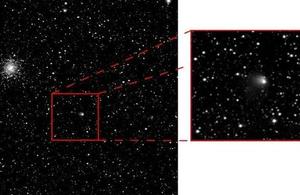Rosetta's target comet gets active
Europe’s Rosetta spacecraft witnesses the awakening of the mission’s target comet.

On April 30th, the comet’s coma extended over 1300 km from the nucleus. For the close up view on the right, a long sequence of images (each with a 10 minute exposure) was taken and stacked. The left panel shows the comet against the star field. Credit:ESA/Rosetta/MPS for OSIRIS Team MPS/UPD/LAM/IAA/SSO/INTA/UPM/DASP/IDA
The comet 67P/Churyumov-Gerasimenko, target of Europe’s Rosetta mission, has begun to develop a dust coma. This can be seen in a series of images taken by OSIRIS, the spacecraft’s scientific imaging system, between March 24th and May 4th. In the images, the dust that the comet is already emitting is clearly visible as an evolving coma and reaches approximately 1300 kilometres into space.
Dr Chris Castelli, Acting Director of Programmes at the UK Space Agency, said:
Rosetta is a big mission for the UK so we’re very excited to see these first images of comet 67P ‘coming to life’. With much of the spacecraft built and designed in the country and UK scientists involved in 10 of the mission’s instruments, we’re looking forward to making history by tracking the evolution of this comet as it swings around the Sun.
Ian Wright, Professor of Planetary Sciences at The Open University, added:
It’s truly great to see these images and witness the beginning of the comet’s active phase. We like activity. It means that the various analytical instruments on board Rosetta will have the opportunity to study the evolution of the ‘cometary phenomenon’. The Ptolemy instrument team can’t wait to get down on the surface and start making measurements on the body of the comet itself.
The images recorded in late-April from a distance of approximately 2 million kilometres show not only a bright nucleus, but also paler structures surrounding it. When comets approach the Sun, volatile gases evaporate from their surface carrying fountains of tiny dust particles with them. In part, these gases and dust remain bound to the nucleus by gravity thus constituting the comet’s coma.

The comet against the star field. Credit:ESA/Rosetta/MPS for OSIRIS Team MPS/UPD/LAM/IAA/SSO/INTA/UPM/DASP/IDA
Still more than 600 million kilometres separate 67P from the Sun. This corresponds to more than four times the distance between the Earth and Sun. This early onset of cometary activity offers scientists the opportunity to study dust production and structures within the coma at an early stage of the mission.
From the changes in brightness that the comet displays periodically over the course of several hours, the OSIRIS team was also able to determine its rotational period. With one full rotation taking12.4 hours, the rotation time is approximately 20 minutes shorter than previously thought.
Rosetta is an ESA mission with contributions from its member states and NASA. Rosetta’s Philae lander is provided by a consortium led by DLR, MPS, CNES and ASI. Rosetta will be the first mission in history to rendezvous with a comet, escort it as it orbits the Sun, and deploy a lander to its surface.
The scientific imaging system OSIRIS was built by a consortium led by the Max Planck Institute for Solar System Research (Germany).
Rosetta and the UK
With funding from the UK Space Agency, Rosetta is a mission with significant UK involvement. UK scientists are involved in ten of the 21 experiments that Rosetta will carry out during its mission:
-
The Open University is leading the team for the Ptolemy instrument on the lander
-
Armagh Observatory will be helping to analyse the results from the OSIRIS instrument
-
Imperial College London and University College London’s Mullard Space Science Laboratory (MSSL) supply the team studying the comet’s plasma
-
Scientists at Oxford University are part of the science team for VIRTIS
-
Queen Mary College at the University of London will be investigating the results of the CONSERT instrument
Industry involvement includes:
-
Astrium Limited, based in Stevenage, was the major subcontractor for the Rosetta platform
-
The Science & Technology Facilities Council (STFC) Rutherford Appleton Laboratory managed to reduce a lab full of chemistry equipment to enable it to fit into a space the size of a shoebox
-
SciSys UK Ltd is responsible for the spacecraft Mission Control System development and maintenance. In recognition of this work on the Rosetta and the Beagle 2 missions, SciSys were awarded the title of “Innovator of the Year” by the UK Computing Awards for Excellence 2004
-
VEGA Group plc was involved in many aspects of the Rosetta mission, from the overall design of the spacecraft to the on board software
-
Technology created by Logica helped to explore some of the issues involved in such a long mission. The company was also involved in the development of the Rosetta on board software
-
AEA Battery Systems Limited provided innovative batteries for the spacecraft and lander. These are smaller, lighter and much more reliable than the traditional nickel-cadmium batteries
-
AEA Technology, European Space Tribology Laboratory (ESTL) developed the Micro-Imaging Dust Analysis System (MIDAS)
-
Polyflex Space Ltd provided tanks to store the helium used by the lander
-
Surrey Satellite Technology Limited (SSTL) designed a wheel that will stabilise the probe as it descends and lands on the comet